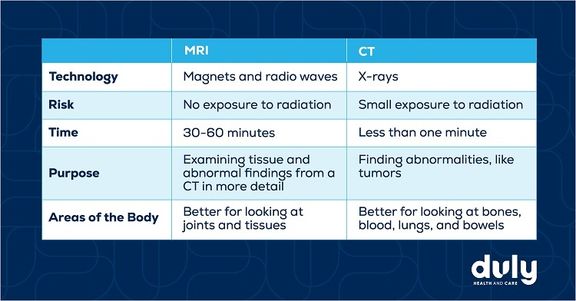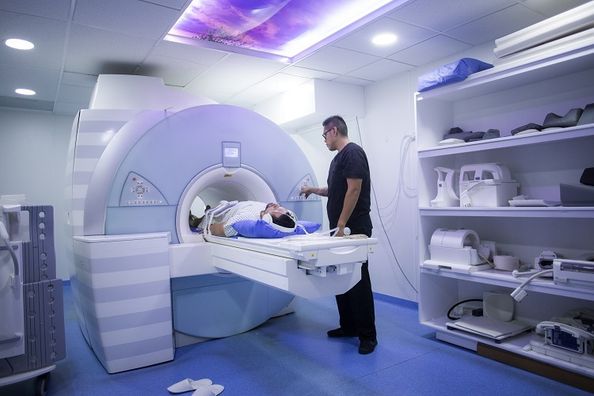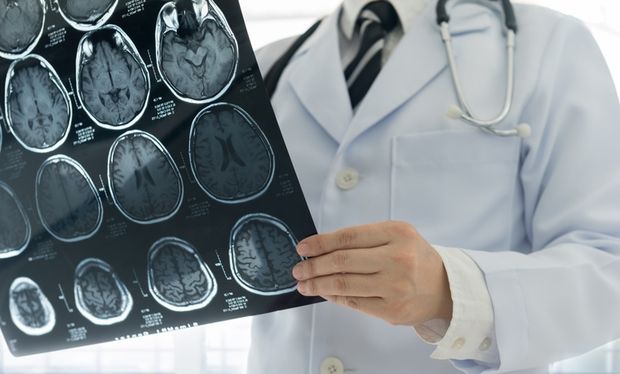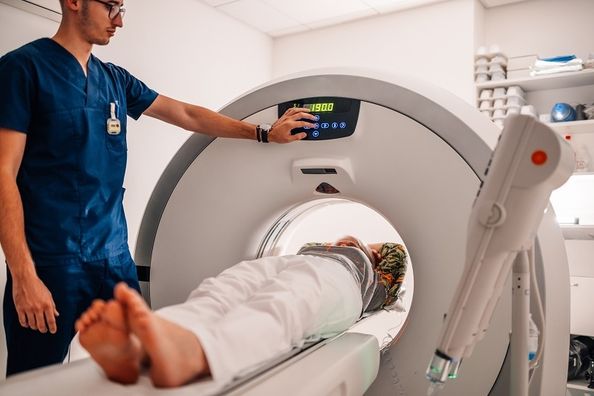You had a computed tomography (CT) scan. Your provider found something abnormal and they wanted a little more information, so they ordered an MRI.
Magnetic resonance imaging or MRI is an imaging test. Many people have heard of them but aren’t fully aware of their purpose or what to expect if they need one.
Here’s a simple guide to MRIs, covering information from why you might need one to what happens during the test to when you will get your results.
MRI: Key Facts at a Glance
- MRI vs. CT: MRI uses magnets and radio waves (no radiation exposure) while CT scans use X‑rays and involve small radiation exposure.
- Timing: MRIs typically take 30 – 60 minutes, while CT scans are much quicker (under a minute).
- Best Uses: MRIs offer clearer images of soft tissues, joints, the brain, and the spine. CT scans are often better for bones, lungs, and detecting tumors.
- Comfort Options: Duly offers closed, open, and wide-bore MRIs to support patients who are claustrophobic or have higher body weight.
- Quick Results: Most MRI results from Duly Health and Care are available within 24 to 48 hours.
What Is an MRI Scan?
An MRI is a non-invasive test that uses a large magnet, radio waves, and a computer to create clear images of structures and organs in your body. Your provider can use the results of an MRI to help diagnose a medical condition or monitor how a condition is responding to treatment.
During an MRI, a special scanner creates a strong magnetic field around you and in your body. The scanner sends and receives radiowaves. A computer uses signals from the transmitter to reconstruct digital images of the part of your body that’s being scanned. The test usually takes about 30 to 60 minutes, and you will need to stay still the whole time.
What are the Different Types of MRIs?
The two main types of MRI are closed- and open-bore. Most MRI scanners are closed. You lay on a moveable table that slides into the opening of a long narrow tube, which encloses you and has openings on each end. There are newer versions called open MRIs, in which you are not enclosed in a tube. Open ones are great if you are claustrophobic (scared of small spaces), but the images aren’t always clear as the ones from closed MRIs.
There are also wide-bore MRIs, which are a sort of happy medium between open and closed. They are technically closed, but they have wider openings that give you more space and headroom. They can be much more comfortable if you’re claustrophobic, but they still provide similar level of quality of images as closed MRIs.
In addition, wide-bore MRIs provide opportunities for more patients to get MRIs. Traditional machines can hold patients who are 400 pounds or less, but wide-bore ones can hold patients who weigh 500+ pounds.
Also read: 4 Benefits of Wide Bore MRI Systems
What Can MRIs Show?
Since MRIs can create images of almost every structure of your body – including bones, organs, blood vessels, and muscles – they are used for many reasons. For example:
- Brain and spinal cord MRIs help diagnose and evaluate brain aneurysms, brain or spinal cord tumors or injuries, pinched nerves, multiple sclerosis, spine anatomy or alignment, or stroke.
- Heart (cardiac) MRIs can help your provider see the anatomy of your heart structures and how they are functioning, diagnose heart conditions, or observe the effects of a heart attack.
- Body MRIs allow your provider to find signs of liver disease, inflammatory bowel disease (like Crohn’s or ulcerative colitis), or tumors in your chest, abdomen, or pelvis.
- Bone and joint MRIs help your provider evaluate bone infections or tumors, disk abnormalities in the spine, or joint problems resulting from injuries.
A word from our Doctor:
“Our radiology staff at Duly strives for quality of service, promptness and excellence. We want to provide the same level of care we would want for our own family. An MRI can seem daunting, but our nurses and technologists are wonderful, and you’ll be in great hands.”
-Dr. Michael Choe, MD, Radiologist with Duly Health and Care
Call to schedule imaging today
Can an MRI Help Diagnose Cancer?
It depends. Often, MRIs help providers find tumors and assisnt in assessing if a tumor is cancerous. They can also use an MRI to see if cancer has spread. However, an MRI isn’t always enough. You may need other types of scans or tests like biopsies (a sample of the tumor is examined under a microscope for signs of cancer) in addition to the MRI.
In some cases, a breast MRI may be able to find certain breast cancers that don’t always show up in mammograms, especially in women with dense breasts. Your provider may recommend getting an MRI in addition to – but not instead of – a mammogram.
How Is an MRI Different From a CT Scan?
Computed tomography or CT scans are another common imaging test. Both MRIs and CTs allow your provider to get a look at what’s happening in your body, but there are several key differences between them.

Also read: Radiology – Types of Imaging Explained
Are MRIs Safe?
In general, MRIs are very safe. The tests don’t expose you to ionizing radiation and do not cause cancer. There is a slight risk of being allergic to contrast (the dye that’s sometimes used during an MRI to enhance the images), but allergies are rare and usually mild. Other than possible nausea or a headache from contrast, there are no side effects of MRIs.
Also read: To Use Contrast, Or Not Use Contrast: That Is The Question
However, there’s a catch. The magnets used in MRIs are very strong and can be dangerous if you have metal in your body, like an implanted pacemaker, metal screws or pins, or an intrauterine device. Patients who are pregnant are safe to receive an MRI, but should not get contrast.
How Do You Prepare? Can You Eat Before an MRI?
There’s good news if you’re getting stressed about an MRI. There is little to no prep work involved. In most cases, you can eat, drink, and take medications normally before the test, unless otherwise instructed. If you need contrast and have had an allergic reaction to it in the past, your provider may have you take medication to help prevent a reaction.
How Long Does It Take to Get the Results of an MRI?
You won’t have to play the waiting game for long. Here at Duly Health and Care, your provider will get the results within 48 hours, but in the majority of cases within 24 hours.
How Much Does an MRI Cost?
The cost of an MRI varies depending on factors like the part of your body being scanned, your insurance, and where you live. Even if you have a high co-pay or have to pay out-of-pocket, try not to let the cost scare you – many health systems have payment plans.
Get a billing estimate from Duly Health and Care >
Where Can I Get an MRI Near Me?
Fortunately, there are many places to get an MRI, so you likely won’t have to travel very far. MRIs can be performed in hospitals, doctors’ offices, or surgery centers.
Find a Duly MRI test location near you >
Have questions about an upcoming MRI or need to schedule an appointment? Talk to your Duly Health and Care primary care provider or call the Radiology Department at 630−545−7880.
Health Topics:





